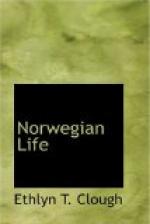Geijer was a romantic by nature, in politics as well as in literature, but he was above all an ardent Scandinavian, opposed to exotics, and passionately devoted to the great traditions of the past, a hero-worshiper, an enthusiast, and a Goth. The Goths were members of a society formed to revive the old national manners and customs, the freedom of the age of the Vikings, and the ardor of the heroes of Walhalla. Their organ was the Idun, an exclusively literary publication. In a letter written by Geijer from Stockholm to his fiancee, then living in the country, dated March 7, 1811, he says: “We have formed a society which meets nearly daily. We talk, smoke, and read together about Gothic Viking deeds. We call each other by Gothic names, and live in the past.” And Anna-Lisa, his future wife, writing to a friend, says: “My fiancee has become a Goth; instead of loving me, he is in love with Valkyries and shield-bearing maidens, drinks out of Viking horns, and carries out Viking expeditions—to the nearest tavern. He writes poems which must not be read in the dark, they are so full of murders and deeds of slaughter.” Ling, who also belonged to this society, was a fervent admirer of the Eddas and Sagas, of the Scandinavian myths and folk-lore. Tegner, despite his classical education and Hellenic turn of mind, was an ardent Norseman in feeling and instinct. “Go to Greece for beauty of form,” he would say, “but to the North for depth of feeling and thought.” He scorned alike the metaphysical subtleties of French philosophy and the moonshine heroics of German romanticism. But he was at one with Geijer and Ling in the desire to make Scandinavian heroes and myths the subjects of poetry.
The result of the movement was Frithiof’s Saga, by Tegner, Geiger’s Viking, and Ling’s heavy epics of Walhalla warriors. But Geijer and Ling alone had followed out the theory in all its consequences. Their heroes were simply Eddic, of their time, in spirit and in thought. Ling’s realism went so far that his Northern gods and warriors, “everlastingly killed but to revive again,” were deemed “pork-eating and mead-drinking yokels.” They were soon forgotten, and Ling himself is best known as the inventor of gymnastic exercises on scientific principles, an art now practiced all the world over as “Swedish gymnastics.” Geijer, whose Viking gave a pure and true picture of Viking life seen in its own light, was himself disappointed. He abandoned poetry and took to history, though Tegner says of him that if he had devoted himself to poetry, he would have surpassed all his contemporaries. As historian he rose to the highest rank; and he is perhaps the greatest historian Sweden has ever produced.




